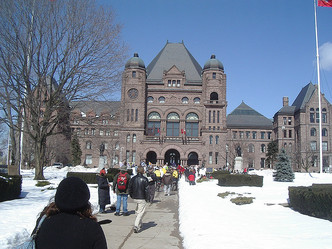 "Iraq War Protest at Queens Park, Toronto" image by Commodore Gandalf Cunningham Personally I doubt there will be protests at Queen's Park on New Year's Day, but my " Attend a 2013 New Year Levee in Toronto" covers even that remote possibility. Perhaps the most useful feature of my latest DeHaan Services article is the special TTC deal on its Day Pass.
Publicity for my Toronto New Year Levees 2013 Article
One Festive Writing Tip for a Toronto New Year Levée While I like to think that my every article has value, today's writing tip is to go the second mile for your readers...when appropriate.
This DeHaan Services article was already getting lengthy, by covering just three Levées on New Year's Day. I could have chosen to include some later Levées by other politicians, but I also needed to explain why so many others were left out.
Then I wondered whether the TTC would provide their usual Sunday "Day Pass" deal for New Year's Day. I checked their web site and found that they actually extend the deal for several days.
That data would be most beneficial to the most readers; and I hadn't thought of checking until deciding that whether my article needed to be shorter rather than longer.
So "in with transit" and "brush off the politicians". In my view, that gave the most benefit to the most readers who might consider attending a
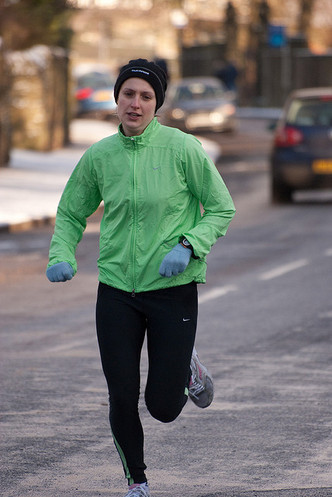 "A Halifax Harrier (UK) Running past Snow" image by AdamKR Nothing says "frugal" and "fit" for the New Year like getting some exercise on New Year's Eve or New Year's Day.
Naturally my DeHaan Services article, " Economy Exercise or Free Rides on New Years Eve 2012 in Toronto", includes running and skating for fitness; free transit for the weary in the GTA; and even some no-charge musical entertainment in the great outdoors. What winter events in Toronto offer these bargains? Um, yes, read my article and learn. Publicizing my Economical New Year's Eve Article
One Frugal Writing Tip for an Economical New Year's Eve
Today's writing tip is to provide value to your readers.
My concrete example is that the article actually covers a lot of different points, each of which could be explained in greater depth.
However, I was in a rush to write the article so it would be published in time for my readers, and also so I could get some other work finished on deadline.
I was sorely tempted to say, for example, "If you use transit in the GTA, go look up the information yourself". I'd noticed that my one reference article had not done this, and I didn't want to take the time myself.
As well, if I use GO Transit or York Regional Transit, I'd probably have their sites bookmarked in my web browser or app'd on my smartphone.
But if I'm going to mention something, I should surely add that bit of service. So I did. And so should you.
Especially if you're writing about special events like getting free trrunning or skating on New Year's Eve in Toronto.
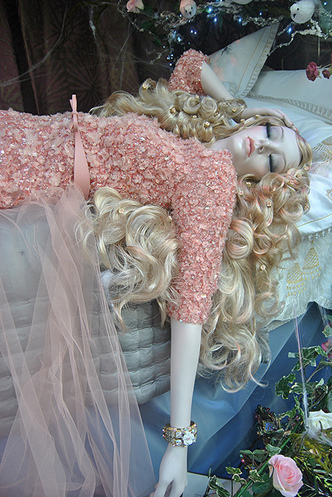 "Beauty Sleep for Sleeping Beauty by Elie Saab at Harrods" image by Loco Steve (Steve Wilson) While "Sleeping Beauty" was not exercising nearly enough, at least she was getting enough sleep to keep her appetite in check. And that's important in the post-holiday season as we make New Year resolutions to lose weight and become more fit. In " Resolve to Lose Weight with More Sleep in the New Year", my DeHaan Fitness article explains several links among sleep, appetite and weight loss.
Publicity for my Resolve to Sleep More Article
One Restful Writing Tip that's not too Weighty
This writing tip restfully repeats something that I've said before. Prepare your mind to keep your eyes open for inspiration.I had already thought, "I really need a timely article for DeHaan Fitness that solves (holiday) seasonal weight gain with a simple New Year resolution". This had simmered in the back of my mind for at least a day or two. Today I read an article about sleep versus appetite. It took very few leaps of logic to adapt that to the holiday season. New Year's Eve is a late night so changes to sleep patterns and loss of shut-eye are common. Appetite and weight control are naturally linked. A few more links became obvious as I worked on the article. The reference article was not tied to a seasonal holiday. But I easily recognized how I could apply their research in the current situation. However, the topic only jumped out at me because I had prepared myself to find and recognize it.WiqiQuotes claims, without a source, that Louis Pasteur said "Luck favours the prepared".As per the Boys Scouts' motto, "Always be prepared". You'll be more lucky in finding weighty inspiration when you need it; especially if you're well-rested.
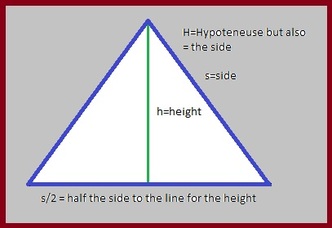 "Height of an Equilateral Triangle" : Image by Mike DeHaan Once again I'm protecting my copyright to original artwork before my next Decoded Science article, " Estimating Whether No Two Snowflakes are Alike", becomes available. Unfortunately, that means I cannot simply save the draft copy. The point is that these images must be publicly available.
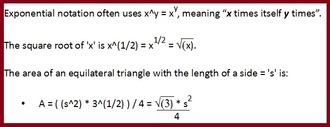 "Mathematical Notation for Exponents and Triangular Area" : Image by Mike DeHaan Since it was published pretty quickly, it's now a moot point.
So go read my article already. The photographs of snowflakes are incredibly prettier than my artwork; and I actually deal with the reader's question.
Publicity for my "Similar Snowflake" Article
One "Cool" Writing Tip for Snowflakes
This writing tip was also delayed; my apologies.
Actually it's an observation from Victoria Nicks, founder of Decoded Science.
Gather meaningful and relevant topics by inviting requests from your readers.
With "engagement" being the watchword, simply ask your readers to pose questions or to suggest topics.
This works especially well if you reply by e-mail to your reader once you've posted the answer in a new article.
Also be sure to publicize your willingness and ability to tackle the questions.
If you can't give a good answer, at least get back and let them know that.
This was at least my second "Expert" article. Certainly for this question, I had to "dig" deep to learn more about snowflakes (and visual resolution!) to supply a framework to determine how likely it is that two snowflakes have ever been alike.
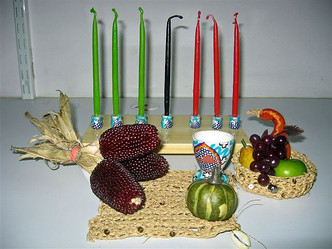 "Kwanzaa Holiday Ceremony Set" image by purejuice2
One Icy Writing Tip
Today's icy writing tip is a two-edged sword.
First, I did feel rather desperate to write something about Kwanzaa. I'd covered Hanukkah, Diwali and Christmas. I did not want to omit this celebration of African heritage simply because there were no public events in Toronto for 2012.
In fact, it may be all the more important to write about something where there's a void.
As you'll see in my article, there was a tie-in with an art exhibition at Harbourfront. So it made some sense to recommend that people go there during Kwanzaa week.
I'd also been meaning to publicize public skating in Toronto's outdoor rinks. However, there are too many to write much about each; and the best coverage is in an existing web site. So it would be hard to make a decent article strictly about skating opportunities.
So the double-edged icy writing tip for situations where you cannot find references that make sense, is to find some relationship to what you do find. It's guaranteed that I have the most recent article about "Kwanzaa in Toronto" because no-one else wrote about it (except for the group that held a teaching session a few weeks earlier). It fills the gap for people who wanted to know about the topic...even if the main message is "no-one really covers this topic".
The second edge of the writing tip is to find ways to include useful material that won't fill a whole article. At the very worst, write a "Ten Tiny Tips" article with the material that wouldn't be used in separate posts.
At this point, I'm curious how many people actually will celebrate 2012 Kwanzaa in Toronto by skating at Harbourfront. Would you skate to
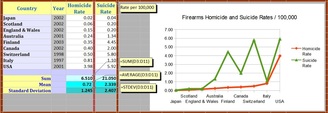 "Nine Countries Firearms Homicide and Suicide Rates in 2006" : image by Mike DeHaan
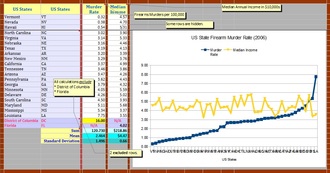 "US States Firearms Murder Rates versus Median Income" : image by Mike DeHaan By publishing images in my own blog first, I establish my copyright for my original work.
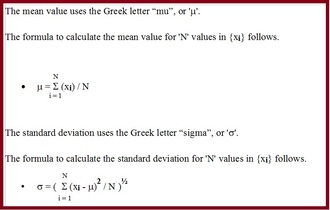 "Math Formulas for Mean and Variance" : image by Mike DeHaan The first two graphs are examples of statistical presentations. The last shows the formulas that spreadsheets use to calculate some of the results.
Publicity for my Gun Statistics Article
A Graphic Writing Tip
My graphic writing tip is that word processors such as Microsoft Word (or Open Office Writer) can be a great help for specific types of technical writing such as mathematics. I sometimes need a graphic tool like Microsoft Paint too.
Some online publishing environments such as WordPress support math symbols. In edit mode, click on the "capital Omega" symbol from the tool list, and out pops that set of characters.
Windows PCs offer the Character Map program to select those characters. You can scroll through all the available fonts to find "symbol". I just tried to paste that "capital Omega" here, but Weebly translated it back into 'W'.
The same fonts are available in Word.
However, I have no idea how to put the superscripts and subscripts directly into WordPress, let alone putting "i=0" and 'N' below and above the summation sign (the "capital Sigma").
Superscripts and subscripts are easy in Word. Just remember to make the font size bigger so it's easily visible in the graphic image.
Once I typed all the symbols and formulas into Word, I zoomed in so that area filled most of the screen. I captured the image by clicking the "Print Screen" key, then pasted it into Paint.
In Paint, I cropped the image to the area I wanted. I also used that tool to capture and move the "i=0" to its new location underneath the "capital Sigma".
A final manipulation adds a thick dark rectangle as the border for the image. Otherwise the white background might simply bleed into the final online article.
So there's my graphic writing tip for including math symbols and formulas into online articles such as my views on gun statistics for firearms homicides such as the recent tragedy in Newtown, CT.
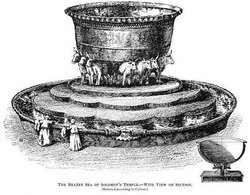 An Artist's Rendition of Solomon's Molten Sea" : image from the Jewish Encyclopedia 1901-06 The Bible's description of this "molten sea " has led some people to speculate that it could define the mathematical constant "pi", or 'π', whose value is approximately 3.14159265... " Did the Temple of Solomon Define Pi in the Bible?" explains how this works, and whether any US states have attempted to use the Bible to define pi. It's my latest article in Decoded Science.
Promoting my "Pi for King Solomon" Article
One Writing Tip as Wise as Solomon
It's a bit too boastful to say that my writing tip could compete with Solomon's wisdom. Go read Proverbs (in the Bible) to see what Solomon had to say about wisdom.
The Decoded Science team was brainstorming online about finding Biblical themes for some science articles. This business about calculating pi is, of course, one of the simpler math puzzles in the Bible.
It's also mentioned in popular literature and urban myth; and my article refers to those situations too.
That's all beside the point of my writing tip, which is to suggest that you avoid making the mistake allows us to be confused by the Bible's report about King Solomon's cast-metal basin.
The problem is that the Biblical story gives too much detail, and also too little.
From the math standpoint, it's not necessary to report both the circumference and diameter of a circle. They are always in a ratio of pi-to-one. The Bible gave too much detail, because it reported both.
Clearly one or the other value was rounded off in the Bible story. Simply saying the diameter was "about so long" would have saved our confusion.
So today's writing tip is to say what you need to say once, but admit it when you're not perfectly accurate. Future generations may thank you for it.
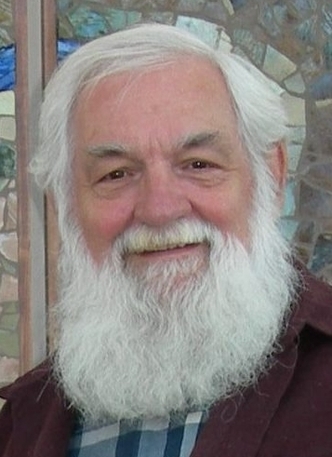 "Gene Stoltzfus Founding Director of Christian Peacemaker Teams" image by Philip E. Stoltzfus via Wikimedia Commons My current Suite 101 article, " Introducing the Christian Peacemaker Teams Organization", deals with a pacifist group launched about a quarter-century ago by several Mennonite denominations. It now has a broader support base. By the way, Christian Peacemaker Teams is not "conflicted" about their mission or methods. That's just my word play because they go to locations where there is tension or conflict.
Promoting my Introduction to Christian Peacemaker Teams One Non-Violent Writing Tip
This is a new and non-violent writing tip. The end of my Suite 101 article cites several online references, and also notes that I updated the contents today. I know one of the authors of one reference article, and asked him to check it first. In this case, I knew that the reference material had left me a bit confused on a couple of details; and of course my article should be as accurate as possible. It's not the first time that I've interviewed a primary source for clarification. I've certainly done it for Decoded Science. The writing tip is: don't hesitate to ask a primary source to help out in various ways. - Confirm or comment before you begin writing.
- Review your draft article for accuracy.
Even though Christian Peacemaker Teams would not attack me physically, it was still better for me to be as accurate as possible.
 "Snow-Covered Chanukah Menorah in East Sussex" image by Dominic's pics (Dominic Alves) When I realized that Hanukkah was upon us, and how few articles I'd written about Jewish events in Toronto, I hastened to write " Celebrating the 2012 Hanukkah in Toronto" in DeHaan Services. My article points to a couple of Hanukkah events outside of synagogues, and gives a brief explanation of the menorah and the origins of this Jewish Festival of Lights. My Xanga blog (" A Very Simple Guide to 2012 Hanukkah in Toronto" ) also publicizes this article.
One Surprising Statistic for Hanukkah
Readers of DeHaan Services almost certainly have noticed that it is a monetized site. Advertisers pay a little for page-views, usually more for clicks on advertising links and definitely should pay if a reader actually buys a product after coming through my site.
The advertising services companies that handle this process also provide some interesting statistics about these click-throughs. Today I was chuffed to see the top outbound link from my article went to the official site for the local organizers of this Hanukkah celebration.
My interpretation is that people read the article and acted to get the extra details they would need.
In this particular case, I think it was important because the follow-up activity consisted of eating in a synagogue or schul, and the official site contained some important notes about that.
Plus, the fact people went to that official site meant that they had not already known about that organization or the event in question.
Therefore my actually presented new information to some people who found it interestng enough to follow through to another site.
One Festive Writing Tip
Today's writing tip is a spin on an old favourite. This week, I'd noticed that Hanukkah was upon us; and also realized that I'd written almost nothing about Jewish celebrations in Toronto. (Other than " Toronto Ashkenaz Festival 2012 at Harbourfront or BuskerFest?", wherein I learned that the Ashkenaz are one branch of modern ethnic Jews). I quickly decided to write about Hanukkah with the same approach as for Christmas caroling or Diwali. I would look for outdoor or public venues, and mention a bit about the history or significance of the event. My impression is that Chanauka is more of a religious and family tradition, rather than something that is celebrated in the town square. Either that, or everyone who wants to know is already well informed through their religious or familiy affiliations.Despite the effort, I feel it is very worthwhile to balance the religious and ethnic coverage in my blog. That fits with my views about inclusiveness. Toronto, of course, has an incredibly diverse population which deserves to be celebrated as much as each group wants. So the writing tip is to keep one ear open for news that you may want to cover; and an eye out for what you've been missing in your articles. Just as I'd been sparse in covering Jewish festivals such as Hanukkah.
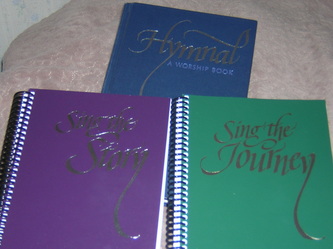 "Mennonite Hymnal and Song Books" by Mike DeHaan. It never rains but it pours. Today's forecast...no, make it a post-cast...calls for heavy image copyright posting here at my Blog of Writing.
Sorry, this is my second incomplete draft post of the day. Normally I only write one post per day, and I prefer them to be complete.
This is also began as a remarkably large image! Fortunately the "resize" tool works.
Publicity for my first Mennonite Music Article
Once this article is published, I also will promote it in DeHaan Services () and in my Xanga blog ().
One Writing Tip about Images for Weebly
Not too long ago, Weebly introduced a "drag" feature for the image loading tool.
The old method required the writer to "browse" through images from a pop-up directory listing.
This was especially annoying because the Weebly editor, or possibly the web browser, remembers the latest folder from which you copied an image. If you work from different folders, it's a nuisance to navigate the folder listings. If you kill the cookie that remembers where you were, your starting position
My writing tip is to use the "drag" feature, especially if you've already opened that folder list to decide which image you want to include.
You already have the right folder open. You already see the image, if you're using a "large icon preview" view.
You certainly don't see a preview of the picture from the Weebly file list.
So, make your life a lot easier. Even if WordPress or Blogger force you to browse a list of file names and navigate your own directory structures, enjoy the simplified Weebly "drag your image" feature.
|














 RSS Feed
RSS Feed